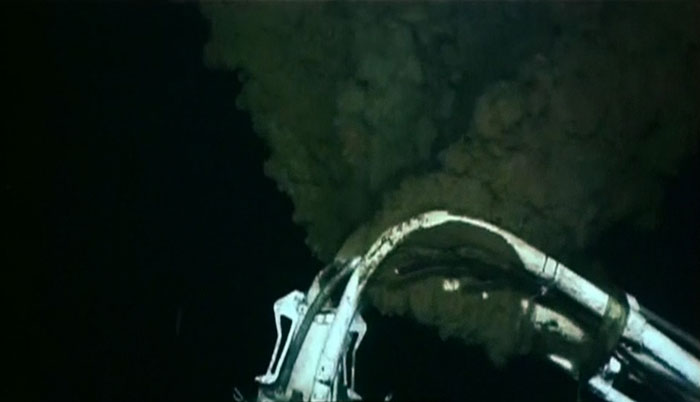Calculating Flow Rate
Deepwater Horizon, 2010
Principal Investigators: Rich Camilli, Andy Bowen
In the early weeks after the explosion of the Deepwater Horizon drill rig, estimates of how much oil was pouring into the Gulf varied widely. This was complicated by the fact that the well had developed multiple leak sites, including one very complex site with numerous small holes where the riser pipe had torn as it was bent above the well's blowout preventer. A reliable figure was crucial to helping everyone involved in battling the spill understand what they were up against.
WHOI researchers Rich Camilli and Andy Bowen offered officials in charge of managing the spill response their long experience developing robotic systems as members of the Deep Submergence Laboratory. They proposed to directly measure the well's leak rate using an acoustic method that had never been attempted before. The approach required equipping one of the robotic submarines working at the well with two specialized types of sonars. The first, a Doppler sonar, measures the velocity of liquids by listening for the change in pitch of sonar echoes, similar to the way a person can detect motion in the sound of a passing automobile based on its change in pitch. Unlike human hearing though, the Doppler sonar listens to frequencies that are more than 50 times higher than the range of a human ear. The second acoustic device, an imaging sonar, measured the cross-sectional area of the well's fluids jetting into the ocean. Much like a medical ultrasound, the imaging sonar is capable of detecting slight differences in density between two materials, such as a stream of hot liquid flowing through cold seawater. This enabled them to measure the girth of each jet coming from the well.
Together, these sonar systems provided the submarine with a sort of X-ray vision to see through the leaks, with the imaging sonar making several thousand detailed “snap shots” of the cross section of a fluid jet in a matter of minutes. Meanwhile, the Doppler sonar recorded the speed of the moving fluid at tens of thousands of locations inside and around the jets. By combining these measurements Camilli built a detailed three-dimensional computer reconstruction of the well’s many leak sites, showing the shapes of each jets and the differences in the speed of fluid movement inside. The computer reconstruction allowed the team to precisely measure the slower movement of fluid at a jet’s perimeter as well as the much faster speeds hidden deep within the jet cores. From this 3D reconstruction the team was able to calculate the oil and gas leakage rate into the ocean.
